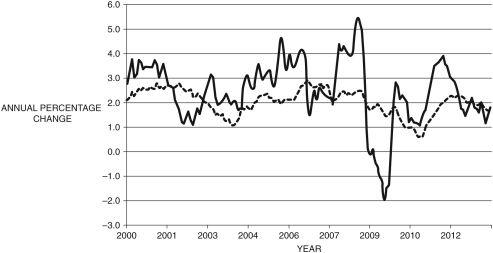Exam 10: The Great Recession: a First Look
Exam 1: Introduction to Macroeconomics35 Questions
Exam 2: Measuring the Macroeconomy111 Questions
Exam 3: An Overview of Long-Run Economic Growth106 Questions
Exam 4: A Model of Production128 Questions
Exam 5: The Solow Growth Model125 Questions
Exam 6: Growth and Ideas114 Questions
Exam 7: The Labor Market, Wages, and Unemployment114 Questions
Exam 8: Inflation111 Questions
Exam 9: An Introduction to the Short Run105 Questions
Exam 10: The Great Recession: a First Look104 Questions
Exam 11: The Is Curve122 Questions
Exam 12: Monetary Policy and the Phillips Curve132 Questions
Exam 13: Stabilization Policy and the Asad Framework109 Questions
Exam 14: The Great Recession and the Short-Run Model104 Questions
Exam 15: Dsge Models: the Frontier of Business Cycle Research114 Questions
Exam 16: Consumption104 Questions
Exam 17: Investment111 Questions
Exam 18: The Government and the Macroeconomy115 Questions
Exam 19: International Trade103 Questions
Exam 20: Exchange Rates and International Finance129 Questions
Exam 21: Parting Thoughts35 Questions
Select questions type
Refer to the following table when answering
Table 10.2: Hypothetical Bank Sheet ($ millions)
Column A Column B Loans \ 6,800 Deposits \ 7,500 Investments 3,700 Short Term Debt 300 Cash \& Reserves 1,100 long Term Debt 1,800
-Given the information in Table 10.2, this bank's liabilities are equal to:
Free
(Multiple Choice)
4.8/5  (27)
(27)
Correct Answer:
A
The increased spread between three-month LIBOR and three-month bond yields led to ________. This is a classic example of ________.
Free
(Multiple Choice)
4.9/5  (42)
(42)
Correct Answer:
A
When the Fed began to raise the federal funds rate in 2004:
Free
(Multiple Choice)
4.9/5  (30)
(30)
Correct Answer:
B
When depositors rush to get their deposits out of a single bank, it is called a bank panic.
(True/False)
4.7/5  (40)
(40)
Refer to the following table when answering
Table 10.2: Hypothetical Bank Sheet ($ millions)
Column A Column B Loans \ 6,800 Deposits \ 7,500 Investments 3,700 Short Term Debt 300 Cash \& Reserves 1,100 long Term Debt 1,800
-Given the information in Table 10.2, the bank's assets are equal to ________ and liabilities are ________.
(Multiple Choice)
4.9/5  (37)
(37)
Which of the following countries did the financial crisis affect?
(Multiple Choice)
4.9/5  (23)
(23)
The following table shows real GDP and potential real GDP for the years 2000-2012. Refer to this table when answering
Table 10.1 ($ billions)
(Source: Federal Reserve Economic Data, St. Louis Federal Reserve)
Potential GDP Real GDP 2000 10,909.7 11,216.4 2001 11,304.5 11,337.5 2002 11,674.3 11,543.1 2003 12,003.6 11,836.4 2004 12,290.0 12,246.9 2005 12,569.2 12,623.0 2006 12,864.6 12,958.5 2007 13,177.7 13,206.4 2008 13,485.0 13,161.9 2009 13,745.4 12,758.0 2010 13,950.3 13,063.0 2011 14,166.6 13,299.1 2012 14,411.0 13,593.2
-According to the data in Table 10.1, when was the recession deepest?
(Multiple Choice)
4.9/5  (29)
(29)
The "flight to safety" in the fall of 2007 led investors to ________, which led to ________.
(Multiple Choice)
4.8/5  (24)
(24)
What incentive did banks have to give large loans to households with relatively little income?
(Multiple Choice)
4.8/5  (34)
(34)
Figure 10.3:  (Source: Federal Reserve Economic Data, St. Louis Federal Reserve)
-Consider Figure 10.3 which shows two types of inflation. Which of the series is likely to be "standard" inflation? Which is core inflation? What is the cause of the sharp increases and decreases in the solid line in the late 2000s?
(Source: Federal Reserve Economic Data, St. Louis Federal Reserve)
-Consider Figure 10.3 which shows two types of inflation. Which of the series is likely to be "standard" inflation? Which is core inflation? What is the cause of the sharp increases and decreases in the solid line in the late 2000s?
(Essay)
4.9/5  (34)
(34)
Between the middle of 2006 and the first quarter of 2012, the national index for the U.S. housing market:
(Multiple Choice)
4.9/5  (34)
(34)
A significant cause of the 2008 financial crisis was that financial institutions were:
(Multiple Choice)
4.9/5  (34)
(34)
In the recent financial crisis, the banks' problems arose from:
(Multiple Choice)
4.7/5  (35)
(35)
The savings glut in the early and mid-2000s led to an increase in U.S. interest rates, which spurred a stock market bubble.
(True/False)
4.8/5  (36)
(36)
Bank leverage is equal to a bank's assets minus its liabilities.
(True/False)
4.8/5  (37)
(37)
Showing 1 - 20 of 104
Filters
- Essay(0)
- Multiple Choice(0)
- Short Answer(0)
- True False(0)
- Matching(0)